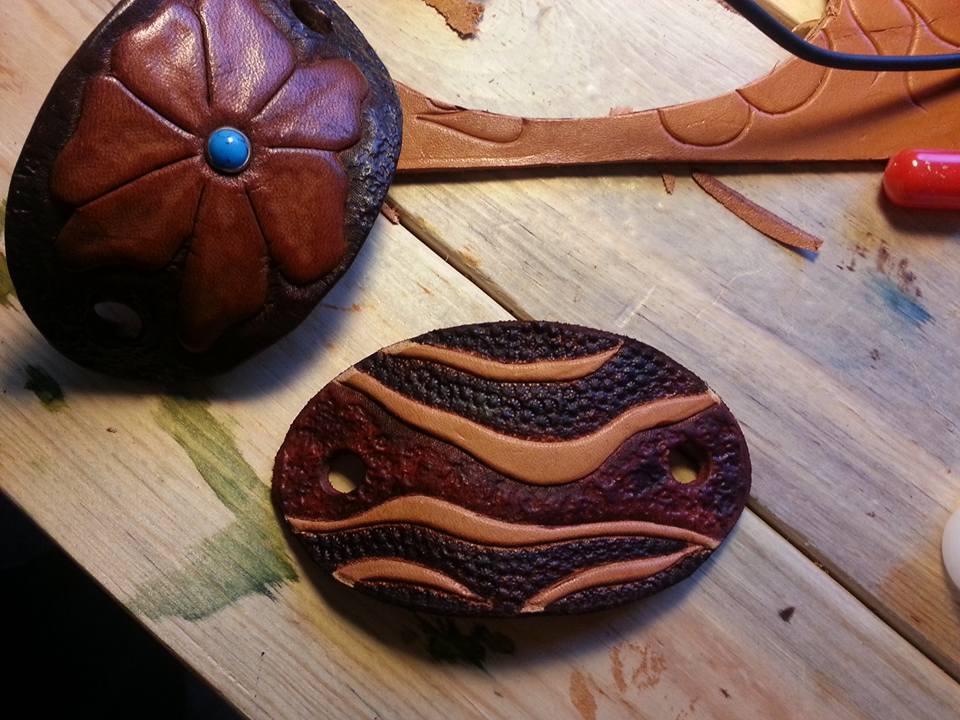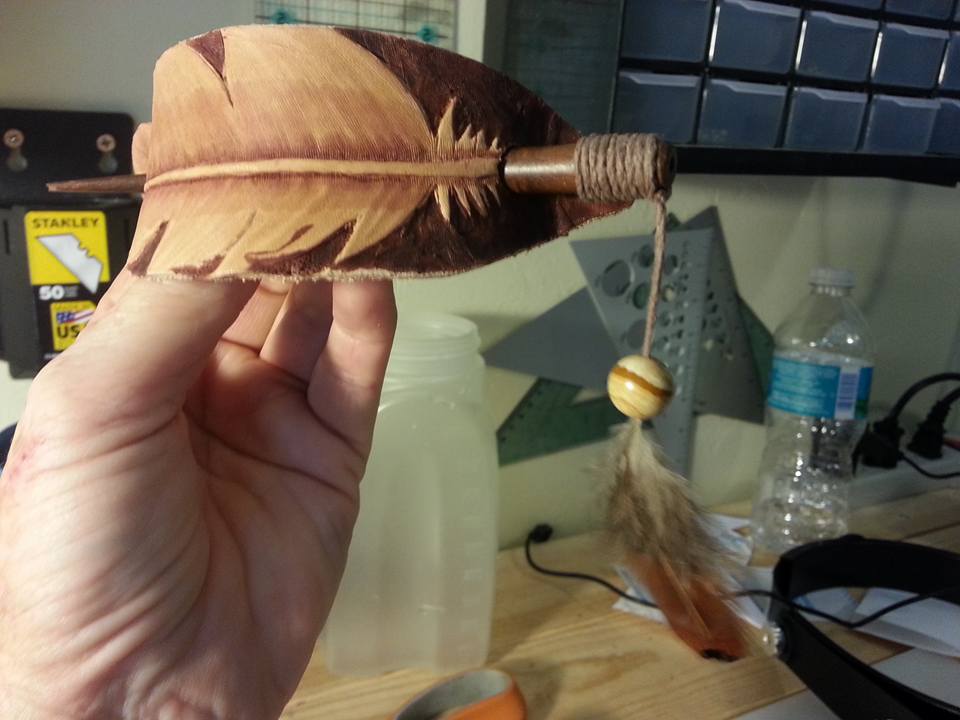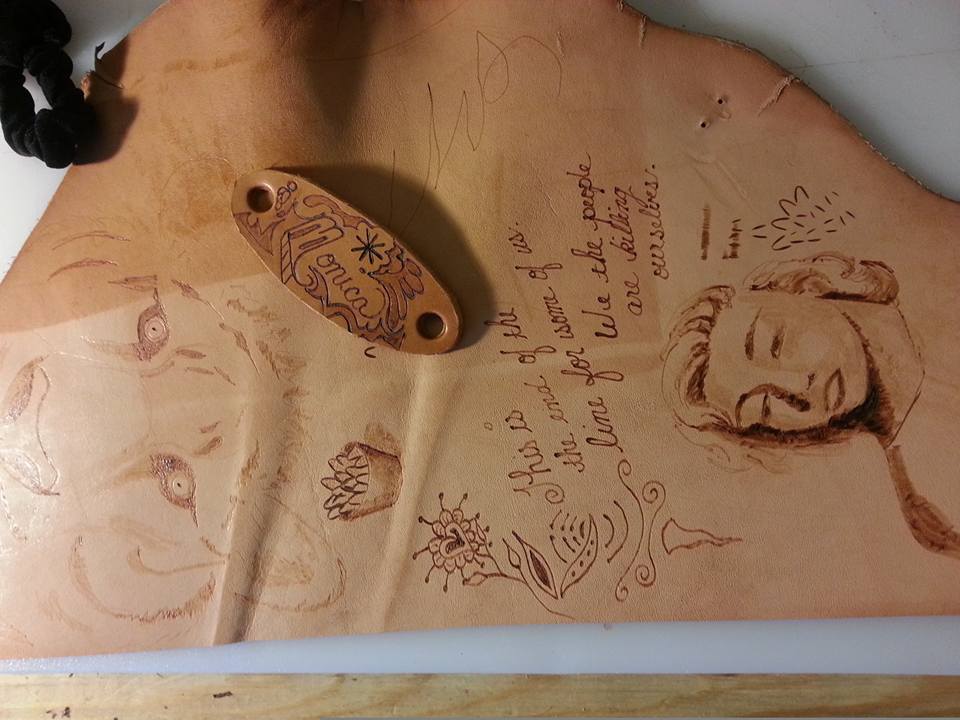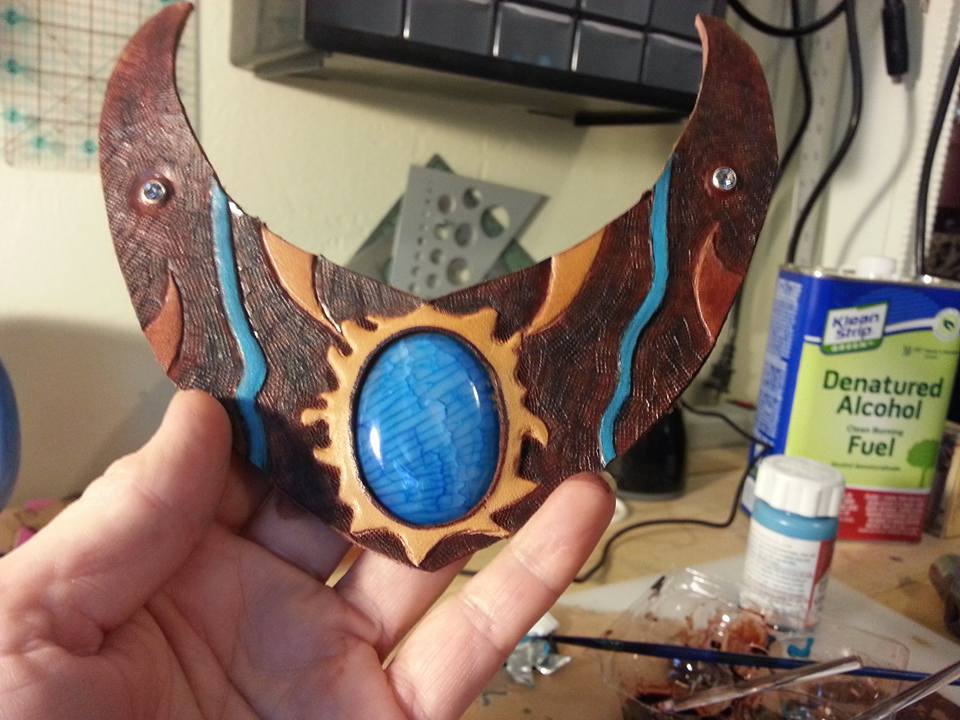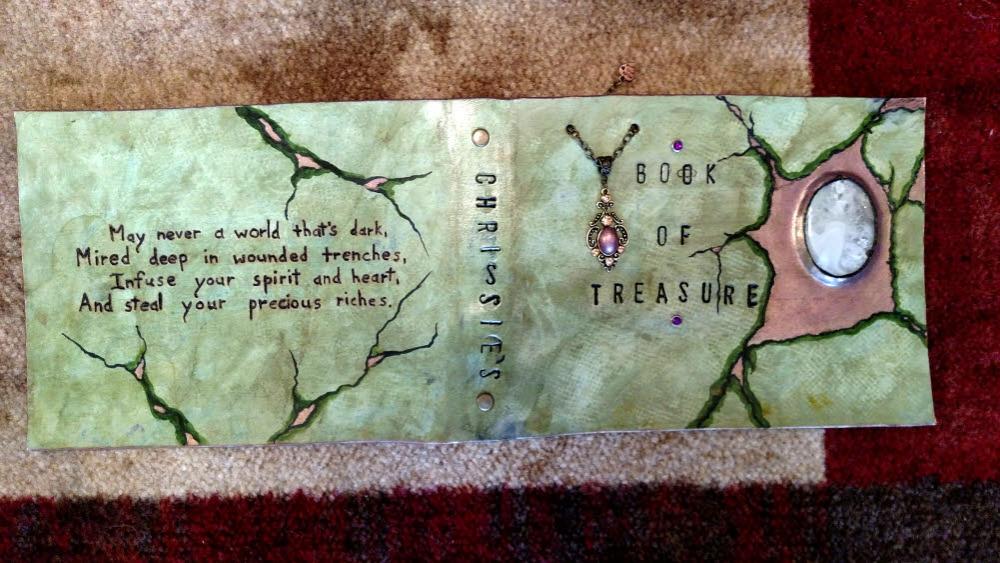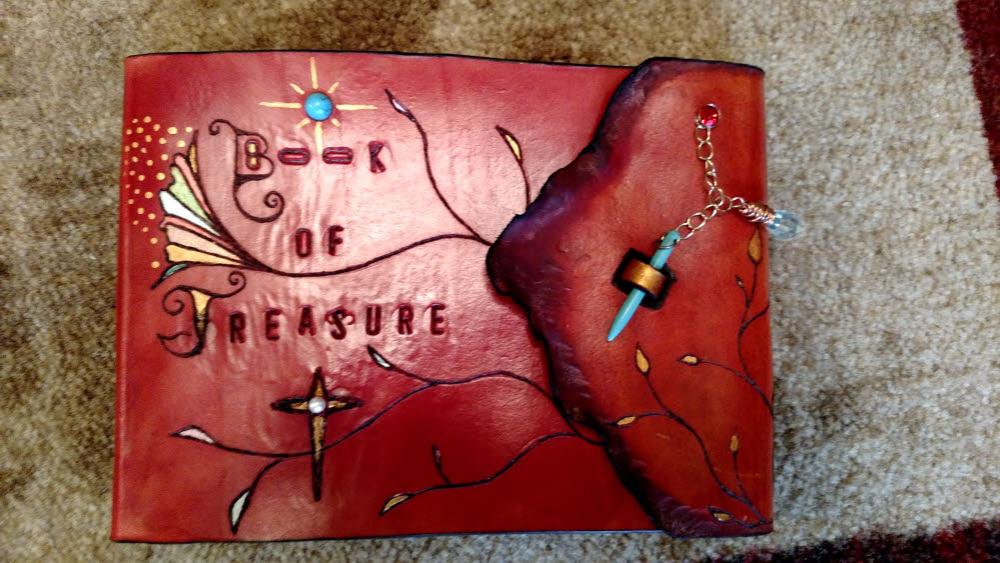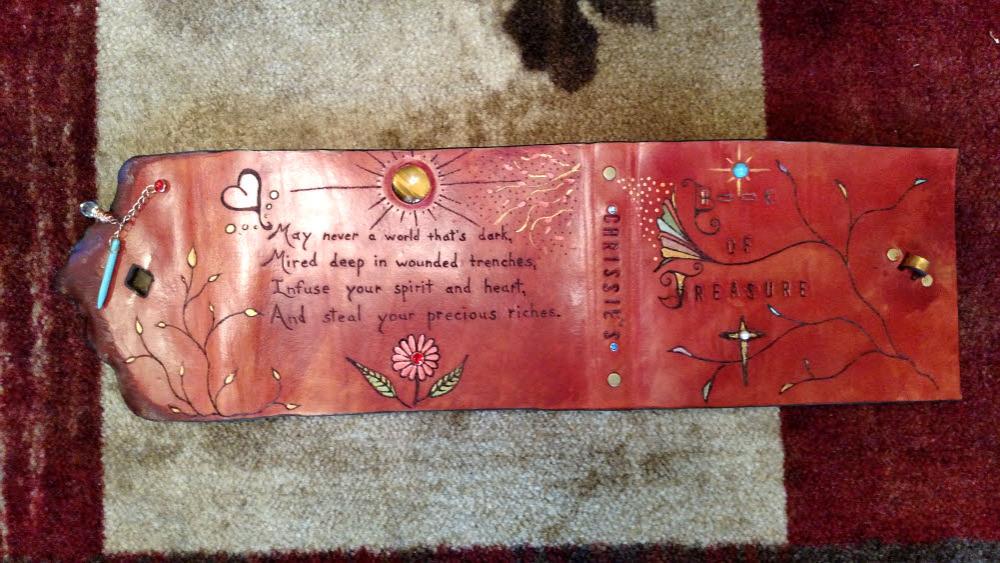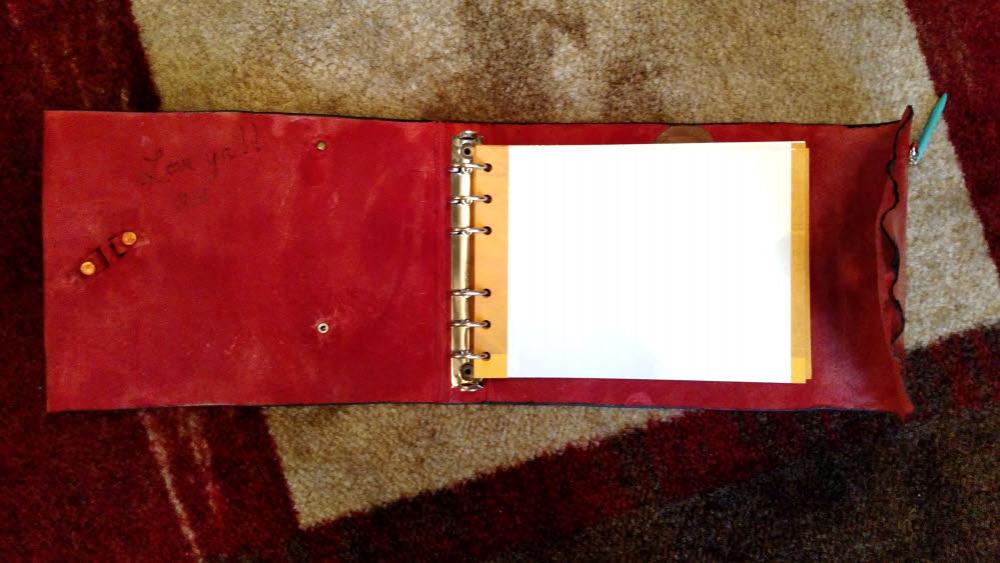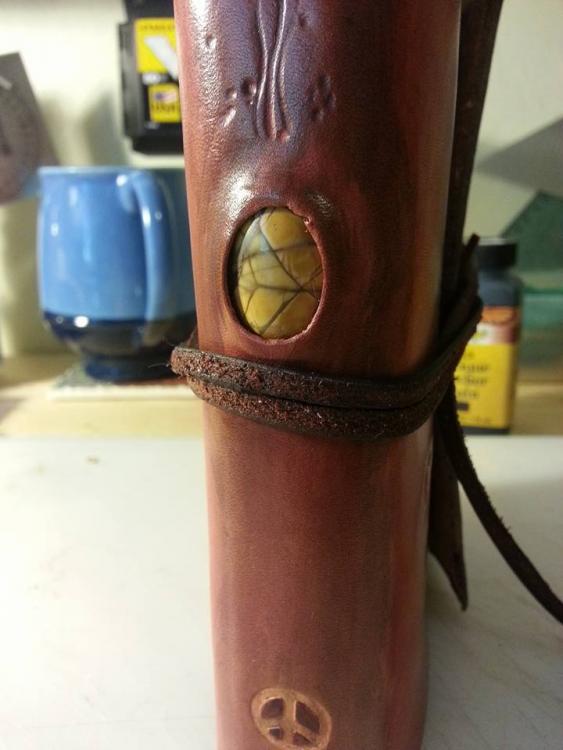-
Posts
1,917 -
Joined
-
Last visited
Content Type
Profiles
Forums
Events
Blogs
Gallery
Everything posted by billybopp
-
Really nice work, as always, Chief!! Bill
-
Leather dyes, paints and finishes can indeed be a complex maze to navigate. There are a lot of products and ways to apply them all with different properties. Combine them in differing combinations and the number of results can be astounding. The best thing that you can do when working on a project, until you learn what works best for you, is to experiment on a scrap piece of leather from your project. A few general pointers, tho .. With all dyes and paints in leather, some colors cover better than others .. you mostly have to experiment to find what works best there. There are essentially two types of dyes, which mostly soak into the leather. Spirit (alcohol) based such as Fiebings dye and fiebings pro, and water based such as eco-flo. The spirit based dyes penetrate a little bit better and can be thinned with alcohol, and will yield nice colors, although generally a bit muted. Water based dyes tend to be somewhat brighter, and can be thinned with water if necessary. Paints are almost all water based acrylics. They adhere to the leather and mostly sit on the surface, and will yield the most vibrant colors. Acrylics made for leather tend to adhere better than those not made for leather. I've done some work with liquitex artist acrylics, and they don't stick as well as the stuff that's designed for leather .. but they do stick well when used atop the leather acrylics. To get really bright colors, you sometimes need to put a coat of white on before the colors, although some folks suggest mixing white with the color that you're using. Yellows, for example, are almost always translucent so have to have an undercoat to show well. Sometimes, you can use that translucent quality to your advantage too! I don't know anything about antique stain since I've never used it, but the antique gel and paste are mostly meant to fill in low spots to give a sort of two tone .. .well .. antique look! It can really bring out the 3-D quality of tooling. The Tandy antique gel does a nice job as a regular dye, and does tend to color at least the acrylic finishes a little, which can be used to your advantage. Fiebings antique paste has only slight effect as a dye, and mostly just settles into low spots .. Sometimes including pores in the leather. To confuse things even further, there are Hi-lighters, which are very thin and will flow into low spots, but I haven't really used them yet. Where finishes are concerned, you've experimented with mostly acrylics as finish and resist. They mostly work well as both, are water based, and can be thinned with either water or with some a thinning medium. Note that matte finishes have a little bit of "grit" in them to scatter light giving that matte look. That grit also can give a slightly (microscopic) bumpy finish, which antiques and other things will stick to, and may darken a bit more than shiny finishes. There are also other classes of finish/resist which are lacquer based. Many folks like the lacquer based finishes such as ClearLac/NeatLac, etc, but I haven't really used them yet. Acrylics tend to be best when you do multiple coats, leaving just a several minutes between so that they will bond together while still not completely dry. When using as a resist, I tend to let them dry at least overnight. If you need a COMPLETE resist, liquid latex over an acrylic can work quite nicely. You could write books on this subject, but above are a few highlights. Remember that the leather itself is also part of these techniques, so best practice is to try what you think will work on a similarly tooled piece of scrap from the project that you are working on! Also .. if you would, please clarify .. Did you try the antique gel on Angelus? If so, it looks like that might be a really good resist for gel! (if that's what you need). Hope that helps Bill
-
It occurs to me that W&C might be willing to sell you some. Since they split to order for customers and some of those probably do not want their splits , they likely have some that they'd be glad to be rid of .. and probably cheaply. Bill
- 24 replies
-
- split leather
- veg splits
-
(and 1 more)
Tagged with:
-
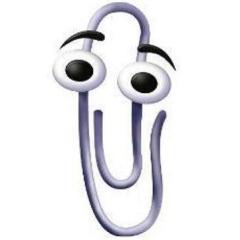
Dip Dye Method
billybopp replied to TomG's topic in Dyes, Antiques, Stains, Glues, Waxes, Finishes and Conditioners.
The voice of experience, I take it? -
I have the Craftool double-ended hair tool too. The blades on mine are removable standard size, and I bought a few really cheap swivel knives on ebay that they fit perfectly. Bill
-
Pretty ingenious use of materials! And darned nice looking results.
-
Lookin' pretty darned good, Colt! I'm always a bit jealous when I see folks making cool stuff like this on here in their workshop .. since I live in a city row house and don't have room for one! (even leatherwork is primarily done in my living room, when the other half lets me). It occurs to me that making your own maul, you have a great opportunity to do some experimentation with materials, designs, and techniques. You could make interchangeable heads to experiment with round vs. varying degrees of taper. While it might mess a bit with balance, you may be able to make some "add-on" weights to fit under the brass end cap (or possibly different weight caps).. and possibly some way to weight the butt-end of the handle to help balance. Just a thought! Bill
-

Dip dying
billybopp replied to ffjdh's topic in Dyes, Antiques, Stains, Glues, Waxes, Finishes and Conditioners.
Dilute the dye and submerge longer. -

Dip dying
billybopp replied to ffjdh's topic in Dyes, Antiques, Stains, Glues, Waxes, Finishes and Conditioners.
How much you dilute kinda depends on the dye and the result that you're looking for.50/50 is a good starting point, tho. You do not need to submerge the whole thing at once. Just get the item under the surface and pull it through relatively slowly .. Maybe 3-4 seconds submerged time for any one section. This way, you can use a relatively small container to dip items. I lay items out flat on a cut open trash bag for a short time to let them dry as evenly as possible. Some like to put belts up on edge, and then flip them after a few minutes. I have wiped items if I see dye pooling in an area. Hope that helps. -

Sheath for a Viking seax
billybopp replied to Harry Marinakis's topic in Gun Holsters, Rifle Slings and Knife Sheathes
It might have been easier getting in and out of a boat, sitting and rowing that way. -
Its not ... And it doesn't do accents well at all.
-
If you REALLY want to know what's being said ... Do not try to use the youtube closed captioning feature. But if you want a good giggle, try it! Bill
-
Contact cement will work quite well. There are a couple of things that you need to watch for, however. If the lining is thin, you need to be especially careful that the contact cement is very smooth. A glue spreader of some sort is helpful for that. Those "sample" credit cards that you get in your mailbox all the time are very effective glue spreaders, and expendable. Contact cement can be a little difficult to align and get flat, so there are a couple of little tricks that can help. 1. Cut the liner a little big and trim off after gluing to compensate for any slight mis-alignment. A piece of plastic sheet can be helpful in letting you glue a bit at a time, when placed between the two pieces being glued. Just put it between the pieces and align them, and pull back the plastic bit by bit pressing the two pieces together as you go. Bill
-

Cutting shoulders straight in quicker time
billybopp replied to RockyAussie's topic in How Do I Do That?
I have a Logan 60" matt cutter that I have found works very nicely for straightening the initial edge for strap cutting. It's extremely easy to use, and big enough to nearly do most double-shoulders. Any remainder that doesn't fit on the cutter is pretty easily extended by a hand cut. It can do a vertical cut, or 45 degree bevel as needed. It also does a nice job of cutting photographic matts, as it was designed to do. Bill -
No doubt, if you're making a bunch a die is the way to go ... but I don't make a bunch of ... well anything! Bill
-
I have a couple of English Point punches in different sizes from different makers, and they are shaped slightly differently when compared side by side, so I don't think there is any exact definition of the shape. As belt end punches are pretty expensive, I only have the sizes that I use most, but can use a larger one for a slightly smaller strap if needed, with a little hand cutting to help the transition to the side look a bit more smooth. When I need a drastically different size, I mark both edges of the belt straight across and then use a compass scribe to mark the curves to the tip. It's close enough to look good, anyway! There are other fairly inexpensive tools available for marking your cuts such as this one. Also, gmace on here posted a quick little video about making an English Point end freehanded and by eye. I'd have to say, tho, that his hand and eye are probably more accurate than mine. I'll stick to punches and marking!! Bill
-
I have a few rotary cutters that I use. They work quite well for thin garment leather and stretchy leather such as deer/elk. They are not so useful for harder veg-tan for me. I do however LOVE having a rotary "paper cutter" that is fantastic for anything up to about 6oz and is the cat's a$$ for squaring up smallish pieces! Bill
-
I like deer or elk. Soft, a bit spongy and very comfy for the guitar straps I've made. Bill
-
Rotary knives work very well for really stretchy leathers such as deer, elk, lamb, etc. Also good for thin leathers, although other knives do OK on thin as well.
-
1/4 inch would be 16 ounce leather. Heavy stuff indeed! You'd be surprised how long you can make leather strips using a tool such as a lace cutter like this : https://www.youtube.com/watch?v=4y_R9ivP0_g . You'd probably want something thicker than the lace cutter can make, but the principal is the same regardless of the tool that you use. If you remember your mythology/history, when Queen Dido and her lot ended up in North Africa in what is now Tunisia. She asked the king there for temporary refuge for her folks .. Just as much as could be encompassed by an ox hide. being the smart gal that she was, she had the hide cut into a very thin continuous strip that marked out pretty big bit of land, which would eventually become the city/state of Carthage. Bill
-
Take a look at lekoza leather slam thread. Lekoza.com
-
I suspect that Stohlman recommended using a stitching groove for several reasons. Most his work that I've seen pictures of were done with heavier leather, where the groove would not make that much difference in terms of strength. His books are also aimed at beginning/intermediate leatherworkers, where a groove front and back will give a good reference for getting awl holes precisely aligned front to back, angle alignment, and also helps to guide an overstitch wheel for marking spacing. I have no doubt that he was aware of pricking irons, and also aware of how expensive they were before the Chinese knock-offs became available. An overstitch wheel is a far less expensive tool (not to mention readily available at the local Tandy store). As mentioned above, there's nothing wrong with a groove in the right circumstances and there are some cases where it's the right aesthetic and is certainly a good thing to know for all levels of experience. I may be wrong, but those are my thoughts! Bill
-
That's cool. I love homemade and repurposed tools!
-
I have a bunch of older Tandy snaps that are fine, but even if the newer ones were top quality I wouldn't buy them. I really don't like the fact that they feel the need to plaster their name all over the new snaps. Bill



